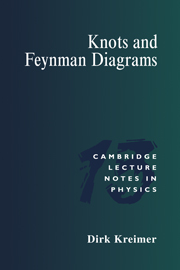Book contents
- Frontmatter
- Contents
- Acknowledgements
- 1 Introduction
- 2 Perturbative quantum field theory
- 3 The Hopf algebra structure of renormalization
- 4 Rationality: no knots, no transcendentals
- 5 The simplest link diagrams
- 6 Necessary topics from knot theory
- 7 Knots to numbers: (2, 2n – 3) torus knots and ζ(2n – 3)
- 8 One-loop words
- 9 Euler–Zagier sums
- 10 Knots and transcendentals
- 11 The four-term relation
- 12 Hopf algebras, non-commutative geometry, and what else?
- References
- Index
6 - Necessary topics from knot theory
Published online by Cambridge University Press: 04 August 2010
- Frontmatter
- Contents
- Acknowledgements
- 1 Introduction
- 2 Perturbative quantum field theory
- 3 The Hopf algebra structure of renormalization
- 4 Rationality: no knots, no transcendentals
- 5 The simplest link diagrams
- 6 Necessary topics from knot theory
- 7 Knots to numbers: (2, 2n – 3) torus knots and ζ(2n – 3)
- 8 One-loop words
- 9 Euler–Zagier sums
- 10 Knots and transcendentals
- 11 The four-term relation
- 12 Hopf algebras, non-commutative geometry, and what else?
- References
- Index
Summary
The purpose of this chapter is to present the most basic information about knot theory necessary to understand Chapters 7 to 10. The presentation is by no means complete. On the contrary, it has to be rather informal. There exist excellent introductions to knot theory in the literature to which we refer interested readers [Rolfsen 1976, Burde and Zieschang 1985, Kauffman 1991, Livingston 1993, Adams 1994, Kawauchi 1996, Murasugi 1996].
Basics
A knot is a smooth mapping ϕ from S1 to R3 without self-intersections. This means that for any such map ϕ we have ϕ(s1) = ϕ(s2) if and only if s1 = s2.
What we are actually interested in are equivalence classes of knots. We call two knots equivalent if we can deform them into each other, without using scissors. More formally, two knots K1, K2 are equivalent, K1 ∼ K2, if there exists an orientation preserving auto-homeomorphism of R3 which maps K1 to K2. Figure 6.1 gives an example.
In a similar vein, we can define link diagrams as a mapping from S1 × S1 × … × S1 to R3. Such links are called n-component links if we started from n copies of S1. The trivial n-link is equivalent to the disjoint union of n circles in the plane and is called µn. The circle itself is also called the unknot.
The most pressing problem of knot theory is to classify the equivalence classes of prime knots.
- Type
- Chapter
- Information
- Knots and Feynman Diagrams , pp. 118 - 129Publisher: Cambridge University PressPrint publication year: 2000



